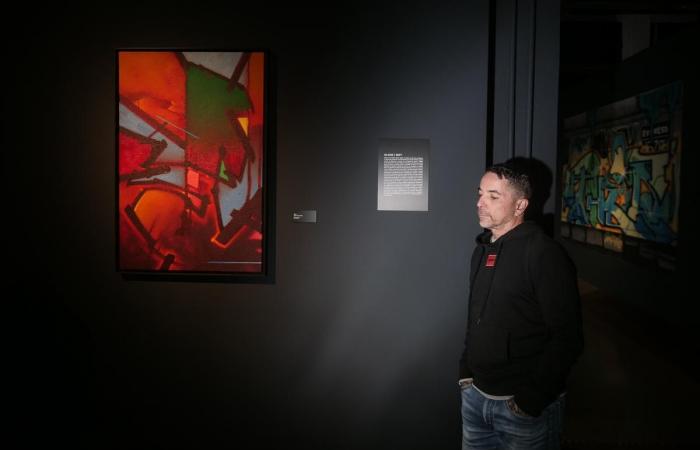Lhe Didam gallery, on the right bank of the Adour, in Bayonne, devotes its new exhibition to a form of art not always considered by aesthetes: graffiti. “The Way out”, the name of this retrospective presented from September 27 until November 10, as part of the Points de vue festival (1), looks back on the codes and origins of this pillar of street art. From its appearance in the 1960s, in the United States, to its arrival on the wastelands of the Parisian suburbs, twenty years later. The great history of the little bomb is retraced here through the work of ten emblematic artists of the movement: Blade, T-Kid 170, Sect (Blaise), Sino, Maxime Drouet, Ulysse Genet, Rap, Dem 189, Lutes and Feito.
Some of them traveled to Bayonne on Friday September 27 to attend the opening. Among the lot, there is Maxime Drouet and his sick smile. The first room of the exhibition is devoted to his work, which experienced a serious slowdown in 2011. After spending ten years taking Parisian metro cars as canvas (those of line H, more specifically), the The artist saw the “tags” brigade of the transport police arrive at his home. Summoned to the police station. Sanctions. This is the end of his adventure in the corridors of the RATP.
From shadow to light
Since then, the young forty-year-old has retrained in spare parts: he paints directly on the scrapyard windows and doors of subway cars abandoned to rust. “I take my time, but I remain on my guard because the problem is the same: we have no right to do that. » “Delinquent” in the eyes of the justice system a few years ago, his success today commands respect. To the point of panicking the galleries. “I have been convicted for graffiti, and today, my work is presented in museums. I also had a poster sponsored by the Ministry of Culture, and one of my works purchased by a very large French museum…”
“Blade” is considered in the history of graffiti as the “king of kings of graffiti”.
Bertrand Lapègue / “South West”
Between rebelling and boasting, Maxime Drouet still hesitates. For gallery owner Amine Bouziane, who accompanied Didam to put together this exhibition, the graffiti artist’s experience could sum up, in itself, the paradox of this underground culture movement. “His case responds to forty years of questioning the transition of graffiti in the world of art. You have artists who will do graffiti on canvas, who will make paintings, but we totally forget the context of the graffiti. Basically, it still remains vandalism and illegality. Today, the real challenge for graffiti is to persist. »
Exhibition within the exhibition, the Kaxu gallery, at 35, rue Sainte-Catherine, presents a series of works allowing us to penetrate further into the universe and the creative process of the artists invited to Didam. An important retrospective devoted to graffiti to which must be added the creation of a new fresco at a place called le MUR, at 7, rue des Lisses, in Petit Bayonne.
(1) The street art festival will take over the walls of Bayonne, from October 16 to 20.
Bertrand Lapègue / “South West”
Blaise, “Sect” by his street name, discovered graffiti as a teenager.







